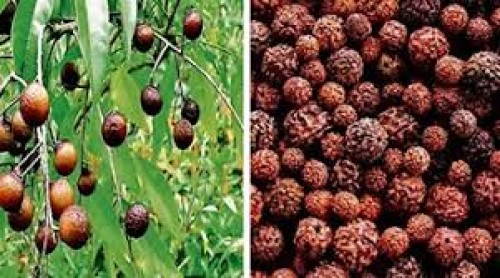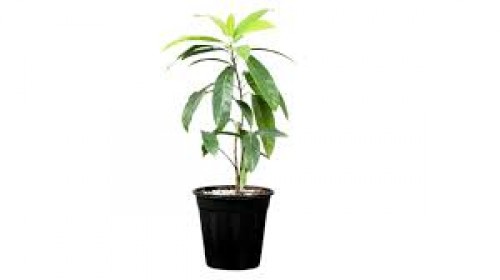off
-
Sold
-

-

out
Rudraksha Plant: Nature, Care & Advantages
Rudraksha (Botanical name: *Elaeocarpus ganitrus*) is a highly revered tree known for its seeds, called "Rudraksha beads," which have significant spiritual and medicinal value. The plant is native to the Himalayas but has spread across tropical and subtropical regions of Asia, including India, Indonesia, and Nepal. Rudraksha trees are considered sacred in Hinduism, Buddhism, and other spiritual traditions, and the seeds are often used in prayer malas (beads) for meditation and spiritual practices.
Nature of the Rudraksha Plant
The Rudraksha plant is a tropical evergreen tree that can grow up to 20 meters in height. It produces small, white, or purple flowers, and its fruit is a drupe that contains the famous Rudraksha seed. These seeds have a unique appearance, with a hard outer shell that is deeply ridged, forming several faces (mukhis) on the seed's surface. The number of ridges varies, with 1 to 21 faces being common, and each face has its own spiritual significance. The Rudraksha plant thrives in well-drained, moist soil and requires a humid, tropical climate to grow effectively.
Care for the Rudraksha Plant
- Climate: Rudraksha plants prefer tropical or subtropical climates with temperatures ranging between 25°C to 35°C (77°F to 95°F). They require a humid environment and are sensitive to cold temperatures, which can stunt growth or damage the plant.
- Soil: The plant thrives in well-drained, moist, slightly acidic soil. A sandy-loam or clay-loam mix with a pH level between 6.0 and 7.5 is ideal. Ensuring proper drainage is essential to prevent waterlogging, which can lead to root rot.
- Watering: Rudraksha trees need moderate watering. The soil should remain moist but not soggy. During the growing season, water the plant regularly, ensuring the soil is not left to dry out completely. In winter, reduce the frequency of watering.
- Sunlight: Rudraksha plants require full sunlight to grow and produce high-quality seeds. Ensure that the plant is placed in an area where it receives at least 6-8 hours of direct sunlight each day.
- Fertilization: Apply organic fertilizers or compost during the growing season to promote healthy growth. Avoid over-fertilizing, as this can affect the plant’s root system and seed production.
- Pruning: Rudraksha trees do not need much pruning, but removing dead or damaged branches will help maintain their health and structure. Regular pruning also ensures better airflow, which reduces the risk of fungal infections.
- Propagation: Rudraksha trees can be propagated from seeds or by using saplings. However, seed germination can take several months, and it requires patience and proper care to ensure the young plants thrive.
Advantages of the Rudraksha Plant
- Spiritual Significance: Rudraksha seeds are considered highly sacred and are used in religious practices, particularly in Hinduism and Buddhism. The beads are strung together to form prayer malas, which are used for meditation, prayer, and mantras. The beads are believed to bring peace, positivity, and spiritual growth to the person wearing or using them.
- Health Benefits: Rudraksha beads are also said to have several health benefits. They are believed to regulate blood pressure, reduce stress, and improve concentration and memory. In traditional medicine, they are used to treat various ailments, including headaches, anxiety, and high blood pressure.
- Medicinal Properties: The seeds of the Rudraksha plant have been traditionally used in Ayurvedic and natural healing systems. The seeds are believed to possess analgesic, anti-inflammatory, and antibacterial properties. They are often used in the treatment of neurological conditions, respiratory issues, and digestive disorders.
- Purification of the Environment: Rudraksha trees are believed to have the ability to purify the air around them. The plant’s positive energy and spiritual significance help cleanse the environment, making it more conducive for meditation and spiritual practices.
- Increased Concentration and Mental Clarity: The use of Rudraksha beads is known to improve mental clarity and enhance concentration. Many spiritual practitioners and students use Rudraksha malas to help focus the mind during meditation and study.
- Natural Aesthetic Appeal: Rudraksha trees also offer an aesthetic advantage. Their broad canopy and lush green foliage make them an attractive addition to gardens and landscapes, and their spiritual symbolism adds to their appeal.
Conclusion
The Rudraksha plant is not only revered for its spiritual significance but also valued for its medicinal properties and positive environmental impact. Growing the plant requires some care, particularly in terms of climate and soil, but the rewards of cultivating this sacred tree far outweigh the effort. Whether used for spiritual practices, health benefits, or enhancing the aesthetic appeal of your space, the Rudraksha plant offers a variety of advantages for both the body and soul.